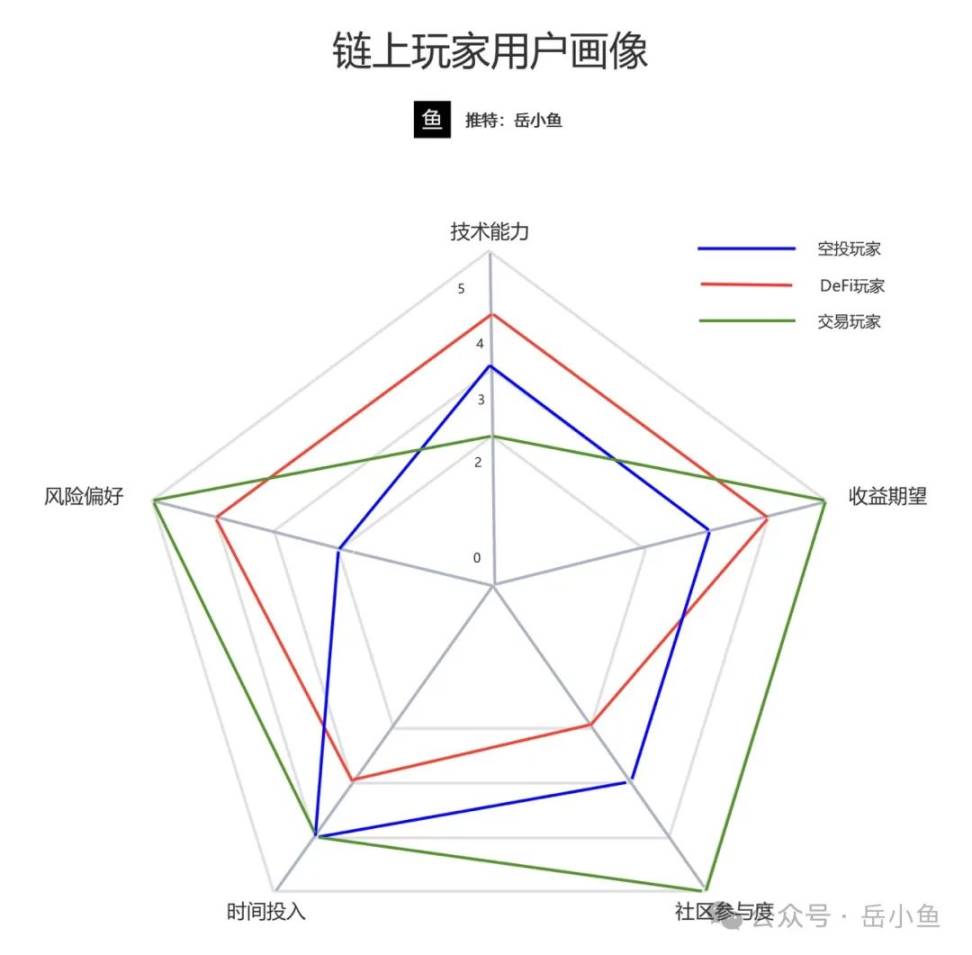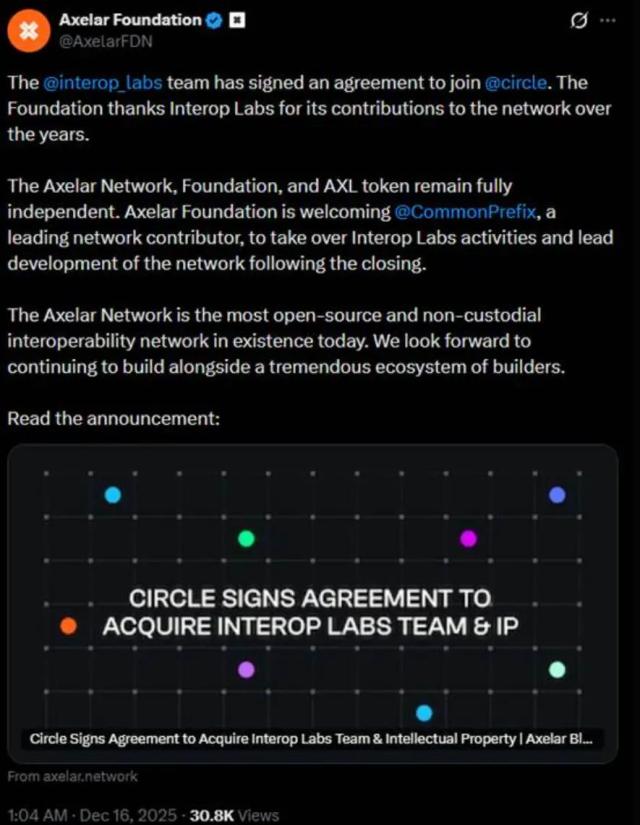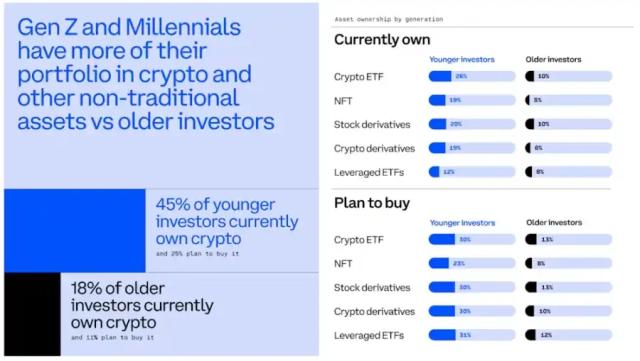Written by: Yue Xiaoyu
On-chain users can be broadly divided into three categories: airdrop players, DeFi players, and trading players.
Airdrop players: These players focus on participating in Web3 project airdrop activities to obtain token rewards at low or even zero cost. Their goal is usually short-term profit, often referred to as "profit hunters".
DeFi players: These users are enthusiastic about DeFi, earning returns by providing liquidity, staking, lending, arbitrage, and other methods, pursuing more stable long-term returns.
Trading players: These specifically refer to large MC memecoin players, primarily speculative, hoping to become wealthy by catching the "golden dog".
These three user groups have very distinctive characteristics, which I will compare comprehensively using a radar chart, allowing everyone to see which type of player they currently are and which type they want to become.
The comparison is divided into 5 dimensions: technical capabilities, risk appetite, time investment, community participation, and return expectations.
The scoring range is 1-5 (1 being the lowest, 5 being the highest).

Conclusion first:
Airdrop players: The radar chart presents a shape tilted towards "time investment", with medium technical capabilities and community participation, low risk appetite and return expectations, forming a relatively balanced but inward pentagon.
DeFi players: The radar chart highlights "technical capabilities" and "risk appetite", with relatively high return expectations, but low community participation and time investment, forming a chart that expands outward but narrows at the bottom.
Meme coin trading players: The radar chart strongly leans towards "risk appetite", "return expectations", and "community participation", with low technical capabilities, forming an overall outward-expanding graph.
You can consider this in conjunction with your behavioral preferences:
If you have plenty of time, no significant capital, and low risk appetite, you are suitable to become an airdrop player;
If you are technically driven, enjoy research, and have a certain amount of funds, you can become a DeFi player;
If you enjoy speculation, can bear high risks, and expect to get rich through trading, you might consider becoming a meme coin player.
Here's a detailed analysis:
1. Airdrop Players
Technical Capabilities (3/5): Need to master basic blockchain operations (such as wallet usage, testnet interaction), but do not need to deeply understand smart contracts or complex DeFi mechanisms.
Risk Appetite (2/5): Low risk, as the investment cost is usually just time and minimal gas fees, with little loss if unsuccessful.
Time Investment (4/5): Requires significant time to research new projects and complete tasks (like Discord activities, interaction tests) to ensure not missing airdrop opportunities.
Community Participation (3/5): Active on Discord, Twitter, etc., but more to complete tasks rather than deeply participating in community culture.
Return Expectations (3/5): Expect considerable returns through airdrops, but due to varying project quality, returns are highly uncertain.
2. DeFi Players
Technical Capabilities (4/5): Need to understand complex DeFi protocols (like Uniswap, Aave), liquidity pool mechanisms, and risk management (such as Impermanent Loss).
Risk Appetite (4/5): Willing to bear higher risks (like smart contract vulnerabilities, market volatility), but usually mitigate losses through diversified investments.
Time Investment (3/5): Need to regularly monitor markets and adjust strategies, but not as frequent as airdrop players.
Community Participation (2/5): More focused on personal returns than community activities, with relatively low participation, unless involved in governance voting.
Return Expectations (4/5): Pursue stable and relatively high annual returns (like 10%-100%), with little interest in short-term wealth.
3. Trading Players
Technical Capabilities (2/5): Simple operations, only requiring basic wallet and trading knowledge, no need for deep technical understanding.
Risk Appetite (5/5): Extremely high risk tolerance, willing to participate in projects with a high probability of "zeroing out", pursuing the dream of "100x coins".
Time Investment (4/5): Mainly dependent on market sentiment and hot topics, requiring constant chain scanning and tracking community dynamics, thus high time investment.
Community Participation (5/5): Highly active in MEME coin communities (like Twitter, Telegram), driving price increases through hype and promotion.
Return Expectations (5/5): Expecting extremely high returns (like 100x or even 1000x), but with extremely low success rates, more of a gambling mentality.
To Summarize
For any type of player, there is no "best", only what suits you best, so find the track that suits you.
For me, my learning path was:
Starting as an airdrop player, experiencing products and learning about projects while earning rewards;
Later becoming a DeFi player, further delving into protocols and on-chain operations, mining for returns everywhere;
And now as an on-chain trading player, catching up with popular narratives and searching for wealth codes on the chain.
My identity and positioning have changed multiple times, but what remains constant is that I continue to learn new things, constantly break through my limitations, and strive to keep up with the industry's rapid development.
Find the track that suits you, and then move forward!








